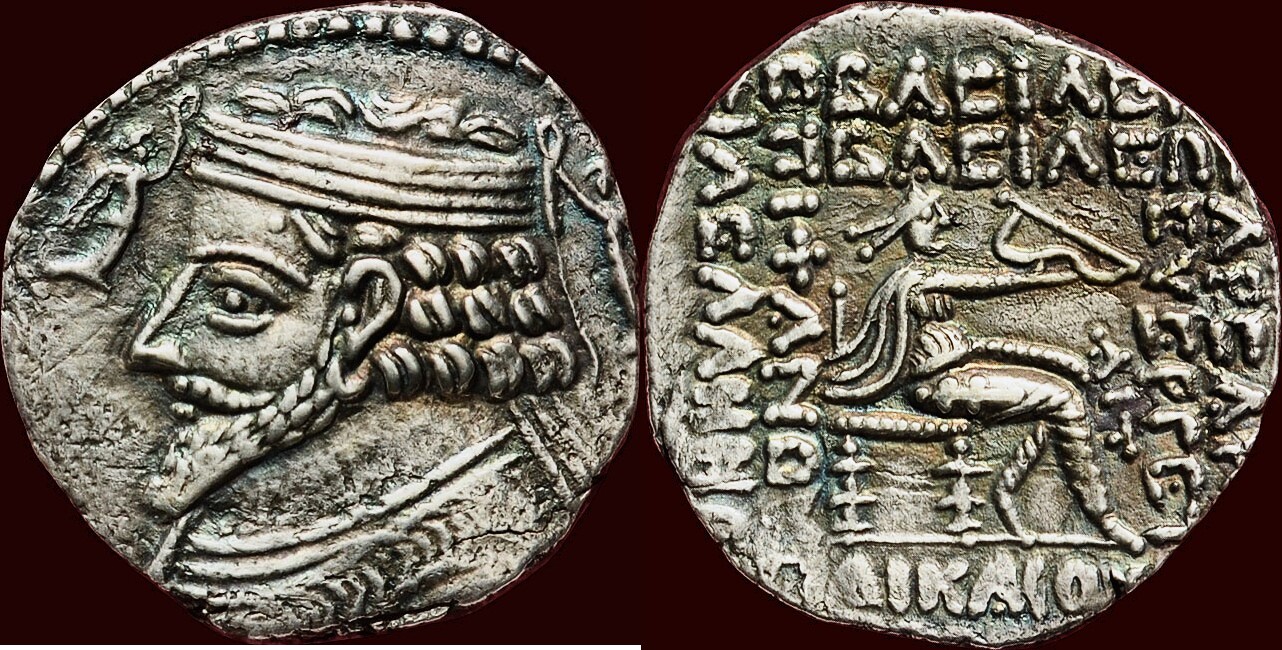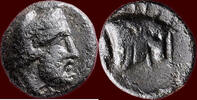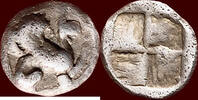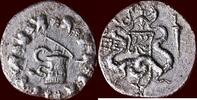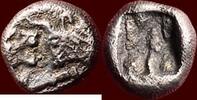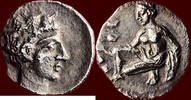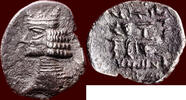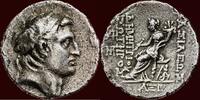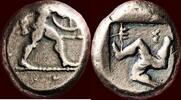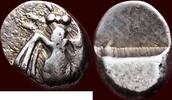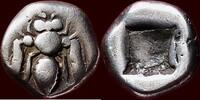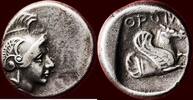MA-ID: 8426302010
Customer feedback Henzen
Schnelle Lieferung. Super Ware. Vielen Dank!
O.K.
perfekt !!!
Great coin, quick delivery, thanks!
AR Tetradrachm 2 BC KINGDOM OF PARTHIA - PHRAATES V (PHRAATAKES), - 4 AD - year 311 (= 2/1 BC), Seleukeia on the Tigris vf / xf
Munthandel G.Henzen 

10
On MA-Shops since 10 years
7244 ratings,
100 % Positive (last 24 months)
Worldwide shipping
736.91 £850,00 EUR
Import tax may be added
+ 22.54 £ shipping ( to United Kingdom )
Delivery time: 5 - 8 days
+ 22.54 £ shipping ( to United Kingdom )
| Customer Support +49 (0)2871 2180 383 |
| Payment methods |
| Wire Transfer |
weight 9,66gr. silver Ø 28mm.
obv. Bust left with pointed beard, wearing diadem and three-band spiral
torque with no visible end ear visible, hair above diadem as ringlets,
below as three waves wart visible on forehead each side of head,
Nike flying with diadem circular border of dots
rev. Beardless archer wearing bashlyk and cloak seated right on throne
with back, holding bow in right hand below bow, Greek letters ΑΙΤ (vertical),
surrounded by a seven-line Greek inscription ΒΑΣΙΛΕΩΣ ΒΑΣΙΛΕΩΝ
ΑΡΣΑΚΟΥ ΕΥΕΡΓΕΤΟΥ ΔΙΚΑΙΟΥ ΕΠΙΦΑΝΟΥΣ ΦΙΛΕΛΛΗΝΟΣ
Phraates V (Phraatakes) was the fifth son of the Phraates IV (r. 37–2 BC) and the first son with his Roman wife Musa, who was originally an Italian slave-girl given to him by the Roman emperor Augustus (r. 27 BC – 14 AD) after a treaty in 20 BC in which the Romans returned Phraates IV his kidnapped son in return for the lost legionary standards taken at Carrhae in 53 BC, as well as any surviving prisoners of war. The Parthians viewed this exchange as a small price to pay to regain the prince. Musa quickly became queen and a favourite of Phraates IV, giving birth to Phraates V (Phraatakes) in c. 19 BC. This fifth son of Phraates IV was regularly known by the diminutive version of his name, Phraatakes. meaning "the small Phraates". It was reportedly under her influence, that Phraates IV in 10/9 BC sent his four first-born sons, all children of earlier marriages, to Rome in order to prevent conflict over his succession. In 2 BC, Musa had Phraates IV poisoned and made herself, along with Phraates V, the co-rulers of the Parthian empire. According to the 1st-century Roman historian Josephus, he heard a rumour that Musa enjoyed sexual relations with her son. This and the coinage of Musa with Phraates V, led to some scholars believe that the two had married. However, there is no evidence that supports this claim neither under the Parthians, nor their Persian predecessors, the Achaemenids, is there reliable evidence that marriage was practised between parents and their children. At his accession, Phraates V inherited a long dispute between the Parthians and the Romans over Armenia and Mesopotamia. As a result, Augustus dispatched an army under his adopted son Caius Caesar to capture both regions. Before war broke out, they were met by an emissary of Phraates V, who demanded the king′s brothers be returned to him. Augustus wrote a mocking response in a letter to Phraates V, which simply addressed him as "Phraates". He demanded that Phraates relinquish his crown and give up his claims to Armenia. Not intimidated, Phraates V replied back, according to the classical Roman historian Cassius Dio "in a generally haughty tone, styling himself King of Kings and addressing Augustus simply as Caesar". Ultimately, the two powers agreed to come to terms through diplomacy: a peace-treaty was agreed in 1 AD, which made Armenia a Roman vassal state, whilst the Romans agreed to acknowledge the Parthian Empire as its equal, and Phraates V as its rightful ruler. It was important to Phraates V that he was acknowledged by the Romans, due to his insecure domestic position in the country. However, this strategy backfired. In 4 AD, the Parthian nobility, already discontented with the son of an Italian slave-girl occupying the throne, were further angered by his acknowledgement of Roman suzerainty in Armenia, expelling Phraates V and Musa from the Parthian throne. Both fled to Rome, where Augustus welcomed them. The Parthian nobility then placed Orodes III on the throne. Like his father, Phraates V′s obverse coins depicts a figure resembling the Greek goddess Nikè holding a ring and diadem behind his head. Likewise, the title of Phraates V on his coinage remained the same as that of his father: ″Basileos Basileon Arsakou Euergetou Dikaiou Epiphanous Philellenos″, translation ″[coin] of the King of Kings, Arsakes, Just, Benefactor, Illustrious, Philhellene.″
Struck in year 311 of the Seleukid Era. These numbers were arranged in backward alphabetic order, from larger to smaller so AIT must be explained as: A = 1, I = 10, T = 300, which results in 311.
The beginning of the Seleukid Era, 312/311 BC, marks the return of Seleukos I to Babylon after the Battle of Gaza. Although the official date is the autumn of 312 BC, some peoples, possibly including the Jews, considered the following year, 311 BC, to be the beginning of the Era. The Seleukid Era was used not only in the Seleukid Empire but also in other Hellenistic empires, and continued in use in some areas, such as among Yemenite Jews, until the 20th century. Parthian coins, particularly tetradrachms minted in Seleukia on the Tigris, frequently utilized the Seleukid Era calendar for dating. Using the Seleukid Era allowed the Parthians to connect with the existing Hellenistic culture and administration in the region, presenting themselves as successors to the Seleucid rulers. It was also used on cuneiform tablets from approximately 306 BC to 75 AD. Ultimately, the Seleukid Era was replaced in Macedonia by the Roman era and in the Near East by the Islamic era.
cf. BMC 5-8 | Sellwood 57/1-9 | SNG.Copenhagen -
Mitchiner ACW.601 | Sear 5759var. | cf. Sunrise 401
cf. Slg. Shore 314-316 R
Very attractive specimen with good details.
A rare historical coin.
vf/xf
obv. Bust left with pointed beard, wearing diadem and three-band spiral
torque with no visible end ear visible, hair above diadem as ringlets,
below as three waves wart visible on forehead each side of head,
Nike flying with diadem circular border of dots
rev. Beardless archer wearing bashlyk and cloak seated right on throne
with back, holding bow in right hand below bow, Greek letters ΑΙΤ (vertical),
surrounded by a seven-line Greek inscription ΒΑΣΙΛΕΩΣ ΒΑΣΙΛΕΩΝ
ΑΡΣΑΚΟΥ ΕΥΕΡΓΕΤΟΥ ΔΙΚΑΙΟΥ ΕΠΙΦΑΝΟΥΣ ΦΙΛΕΛΛΗΝΟΣ
Phraates V (Phraatakes) was the fifth son of the Phraates IV (r. 37–2 BC) and the first son with his Roman wife Musa, who was originally an Italian slave-girl given to him by the Roman emperor Augustus (r. 27 BC – 14 AD) after a treaty in 20 BC in which the Romans returned Phraates IV his kidnapped son in return for the lost legionary standards taken at Carrhae in 53 BC, as well as any surviving prisoners of war. The Parthians viewed this exchange as a small price to pay to regain the prince. Musa quickly became queen and a favourite of Phraates IV, giving birth to Phraates V (Phraatakes) in c. 19 BC. This fifth son of Phraates IV was regularly known by the diminutive version of his name, Phraatakes. meaning "the small Phraates". It was reportedly under her influence, that Phraates IV in 10/9 BC sent his four first-born sons, all children of earlier marriages, to Rome in order to prevent conflict over his succession. In 2 BC, Musa had Phraates IV poisoned and made herself, along with Phraates V, the co-rulers of the Parthian empire. According to the 1st-century Roman historian Josephus, he heard a rumour that Musa enjoyed sexual relations with her son. This and the coinage of Musa with Phraates V, led to some scholars believe that the two had married. However, there is no evidence that supports this claim neither under the Parthians, nor their Persian predecessors, the Achaemenids, is there reliable evidence that marriage was practised between parents and their children. At his accession, Phraates V inherited a long dispute between the Parthians and the Romans over Armenia and Mesopotamia. As a result, Augustus dispatched an army under his adopted son Caius Caesar to capture both regions. Before war broke out, they were met by an emissary of Phraates V, who demanded the king′s brothers be returned to him. Augustus wrote a mocking response in a letter to Phraates V, which simply addressed him as "Phraates". He demanded that Phraates relinquish his crown and give up his claims to Armenia. Not intimidated, Phraates V replied back, according to the classical Roman historian Cassius Dio "in a generally haughty tone, styling himself King of Kings and addressing Augustus simply as Caesar". Ultimately, the two powers agreed to come to terms through diplomacy: a peace-treaty was agreed in 1 AD, which made Armenia a Roman vassal state, whilst the Romans agreed to acknowledge the Parthian Empire as its equal, and Phraates V as its rightful ruler. It was important to Phraates V that he was acknowledged by the Romans, due to his insecure domestic position in the country. However, this strategy backfired. In 4 AD, the Parthian nobility, already discontented with the son of an Italian slave-girl occupying the throne, were further angered by his acknowledgement of Roman suzerainty in Armenia, expelling Phraates V and Musa from the Parthian throne. Both fled to Rome, where Augustus welcomed them. The Parthian nobility then placed Orodes III on the throne. Like his father, Phraates V′s obverse coins depicts a figure resembling the Greek goddess Nikè holding a ring and diadem behind his head. Likewise, the title of Phraates V on his coinage remained the same as that of his father: ″Basileos Basileon Arsakou Euergetou Dikaiou Epiphanous Philellenos″, translation ″[coin] of the King of Kings, Arsakes, Just, Benefactor, Illustrious, Philhellene.″
Struck in year 311 of the Seleukid Era. These numbers were arranged in backward alphabetic order, from larger to smaller so AIT must be explained as: A = 1, I = 10, T = 300, which results in 311.
The beginning of the Seleukid Era, 312/311 BC, marks the return of Seleukos I to Babylon after the Battle of Gaza. Although the official date is the autumn of 312 BC, some peoples, possibly including the Jews, considered the following year, 311 BC, to be the beginning of the Era. The Seleukid Era was used not only in the Seleukid Empire but also in other Hellenistic empires, and continued in use in some areas, such as among Yemenite Jews, until the 20th century. Parthian coins, particularly tetradrachms minted in Seleukia on the Tigris, frequently utilized the Seleukid Era calendar for dating. Using the Seleukid Era allowed the Parthians to connect with the existing Hellenistic culture and administration in the region, presenting themselves as successors to the Seleucid rulers. It was also used on cuneiform tablets from approximately 306 BC to 75 AD. Ultimately, the Seleukid Era was replaced in Macedonia by the Roman era and in the Near East by the Islamic era.
cf. BMC 5-8 | Sellwood 57/1-9 | SNG.Copenhagen -
Mitchiner ACW.601 | Sear 5759var. | cf. Sunrise 401
cf. Slg. Shore 314-316 R
Very attractive specimen with good details.
A rare historical coin.
vf/xf
Please respect our order minimum of 20 Euros. For EU only IBAN payment please. Shippings to China are on risk of the buyer and only payment by bankwire or WISE. Shipping will take place within 5 days after receipt of payment. Sendings to Russia,Ukraine and Israel are not possible. Additional administration- and risk costs for PayPal & creditcard payments. No PayPal or creditcardpayments possible for orders over 10.000 euro.
| Shipping fees | ||||
|---|---|---|---|---|
| up to 86.70 £ | 86.70 £ to 433.48 £ | 433.48 £ to 866.95 £ | over 866.95 £ | |
| Argentina | 27.74 £ | 27.74 £ | 34.68 £ | 34.68 £ |
| Australia | 30.34 £ | 30.34 £ | 34.68 £ | 34.68 £ |
| Belgium | 8.24 £ | 9.54 £ | 11.27 £ | 15.61 £ |
| Brazil | 47.68 £ | 47.68 £ | 47.68 £ | 47.68 £ |
| Bulgaria | 12.14 £ | 13.87 £ | 30.34 £ | 39.01 £ |
| Chile | 43.35 £ | 43.35 £ | 43.35 £ | 43.35 £ |
| China | 34.68 £ | 34.68 £ | 43.35 £ | 43.35 £ |
| Denmark | 9.97 £ | 11.27 £ | 13.87 £ | 17.34 £ |
| Germany | 8.24 £ | 9.54 £ | 11.27 £ | 15.61 £ |
| Estonia | 11.27 £ | 12.14 £ | 13.00 £ | 21.67 £ |
| France | 8.24 £ | 9.54 £ | 13.87 £ | 21.67 £ |
| Greece | 13.00 £ | 21.67 £ | 26.01 £ | 30.34 £ |
| United Kingdom | 21.67 £ | 21.67 £ | 22.54 £ | 24.27 £ |
| Hong Kong | 34.68 £ | 34.68 £ | 43.35 £ | 43.35 £ |
| India | 30.34 £ | 30.34 £ | 34.68 £ | 43.35 £ |
| Indonesia | 30.34 £ | 30.34 £ | 34.68 £ | 34.68 £ |
| Israel | 173.39 £ | 173.39 £ | 173.39 £ | 173.39 £ |
| Japan | 34.68 £ | 34.68 £ | 34.68 £ | 34.68 £ |
| Cambodia | 56.35 £ | 56.35 £ | 56.35 £ | 56.35 £ |
| Canada | 26.01 £ | 26.01 £ | 30.34 £ | 30.34 £ |
| Liechtenstein | 17.34 £ | 17.34 £ | 21.67 £ | 21.67 £ |
| Luxembourg | 9.54 £ | 11.27 £ | 13.87 £ | 21.67 £ |
| Malaysia | 30.34 £ | 30.34 £ | 34.68 £ | 39.01 £ |
| Netherlands | 7.37 £ | 7.37 £ | 9.54 £ | 12.14 £ |
| Norway | 21.67 £ | 21.67 £ | 26.01 £ | 30.34 £ |
| Austria | 9.97 £ | 10.84 £ | 13.00 £ | 21.67 £ |
| Poland | 11.27 £ | 12.14 £ | 14.30 £ | 21.67 £ |
| Portugal | 11.27 £ | 12.14 £ | 15.61 £ | 21.67 £ |
| Romania | 13.87 £ | 15.61 £ | 21.67 £ | 30.34 £ |
| Russian Federation | 173.39 £ | 173.39 £ | 173.39 £ | 173.39 £ |
| Switzerland | 26.01 £ | 26.01 £ | 34.68 £ | 34.68 £ |
| Serbia | 21.67 £ | 21.67 £ | 26.01 £ | 30.34 £ |
| Singapore | 30.34 £ | 30.34 £ | 30.34 £ | 34.68 £ |
| Slovakia | 11.27 £ | 13.00 £ | 17.34 £ | 21.67 £ |
| Spain | 9.97 £ | 11.70 £ | 14.30 £ | 21.67 £ |
| Sri Lanka | 30.34 £ | 30.34 £ | 34.68 £ | 39.01 £ |
| Czech Republic | 10.40 £ | 12.14 £ | 15.61 £ | 21.67 £ |
| Ukraine | 173.39 £ | 173.39 £ | 173.39 £ | 173.39 £ |
| Hungary | 12.14 £ | 13.87 £ | 21.67 £ | 26.01 £ |
| United States | 27.74 £ | 27.74 £ | 30.34 £ | 34.68 £ |
| European Union | 13.00 £ | 14.74 £ | 21.67 £ | 26.01 £ |
| World | 34.68 £ | 34.68 £ | 43.35 £ | 43.35 £ |
Information
Online orders are welcome as always and will be shipped directly.
|
Seller Home | 0Shopping cart | Terms of sale | Contact | MA Terms of sale | Privacy policy | Warranty | MA-Shops New Items Copyright ® 2001-2025, MA-SHOPS Coins All Rights Reserved. Designated trademarks and brands are the property of their respective owners. |
 Buy coins with warranty
Buy coins with warranty



